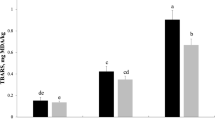Abstract
Aqueous extract of mate (dried leaves of Ilex paraguariensis) added to drinking water for broilers for the last 14 days prior to slaughter did not affect performance at 25 days of age, but improved oxidative stability of the chicken meat. Oxidative stability of precooked breast meat made from control meat (CON) and from meat of broilers raised on water with mate added was investigated during chill storage for up to 7 days. The use of mate showed no influence on the content of lipids in chicken breast meat; however, lipid oxidation measured as thiobarbituric acid–reactive substances (TBARS) was significantly lower for meat from broilers raised on water with mate extracts in different concentrations (MA0.1, MA0.5, and MA1.0 corresponding to 0.1, 0.5, and 1.0% of mate dried leaves). The relative effect was largest at 1 day of storage with more than 50% reduction on TBARS; the result was still significant after 3 days, but almost vanished after 7 days, when oxidative rancidity was very high in all samples. In meat from broilers raised on water with mate extract, vitamin E was protected during cooking, although in the very rancid meat balls at 7 days of storage, the protection almost disappeared. Nevertheless, mate can be an interesting natural alternative to be used in chicken diets to improve lipid stability of the meat.

Similar content being viewed by others
References
Engberg RM, Lauridsen C, Jensen SK, Jakobsen K (1996) Inclusion of oxidised vegetable oil in broiler diets: its influence on nutrient balance and on antioxidative status of broilers. Poult Sci 75:1003–1011
Lin CF, Asghar A, Gray JI, Buckley DJ, Booren AM, Crackel RL, Flegal CJ (1989) Effects of oxidized dietary oil and antioxidant supplementation on broiler growth and meat stability. Brit Poultry Sci 30:855–864
Morrissey PA, Sheehy PJA, Galvin K, Kerry JP, Buckley DJ (1998) Lipid in meat and meat product. Meat Sci 49(S1):S73–S86
Madsen HL, Bertelsen G (1995) Spices as antioxidants. Trends Food Sci Tech 6:271–277
Racanicci AMC, Allesen-Holm BH, Skibsted LH (2009) Sensory evaluation of precooked chicken meat with mate (Ilex paraguariensis) added as antioxidant. Eur Food Res Technol 229:277–280
Filip R, Ferraro GE (2003) Researching on new species of “Mate”: Ilex brevicuspis-phytochemical and pharmacology study. Eur J Nut 42:50–54
Filip R, López P, Giberti G, Coussio J, Ferraro G (2001) Phenolic compounds in seven South American Ilex species. Fitoterapia 72:774–778
Schinella GR, Troiani G, Dávila V, de Buschiazzo PM, Tournier HA (2000) Antioxidant effects of an aqueous extract of Ilex paraguariensis. Biochem Bioph Res Co 269:357–360
Heck CI, de Mejia EG (2007) Yerba Mate Tea (Ilex paraguariensis): a comprehensive review on chemistry, health implications, and technological considerations. J Food Sci 72:138–151
Campos RML, Hierro E, Ordóñez JA, Bertol TM, Terra NN, de la Hoz L (2007) Fatty acid and volatile compounds from salami manufactured with yerba mate (Ilex paraguariensis) extract and pork back fat and meat from pigs fed on diets with partial replacement of maize with rice bran. Food Chem 103:1159–1167
Racanicci AMC, Danielsen B, Skibsted LH (2008) Mate (Ilex paraguariensis) as a source of water extractable antioxidant for use in chicken meat. Eur Food Res Technol 227:255–260
Singleton VL, Rossi JA Jr (1965) Colorimetry of total phenolics with phosphomolybdic-phosphotungstic acid reagents. Am J Enol Viticult 16:144–158
Kähkönen MP, Hopia AI, Vuorela HJ, Rauha J, Pihlaja K, Kujala TS, Heinonen M (1999) Antioxidant activity of plant extracts containing phenolic compounds. J Agri Food Chem 47:3952–3954
Racanicci AMC, Danielsen B, Menten JFM, Regitano-d’Arce MAB, Skibsted LH (2004) Antioxidant effect of dittany (Origanum dictamnus) in pre-cooked chicken meat balls during chill-storage in comparison to rosemary (Rosmarinus officinalis). Eur Food Res Technol 218:521–524
Bligh EG, Dyer WJ (1959) A rapid method of total lipid extraction and purification. Can J Biochem Phys 37:911–917
Hartman L, Lago RC (1973) Rapid determination of fatty acid methyl esthers from lipids. Lab Practice 22:475–476
Madsen HL, Sørensen B, Skibsted LH, Bertelsen G (1998) The antioxidative activity of summer savory (Satureja hortensis L) and rosemary (Rosemarinus officinalis L) in dressing stored exposed to light or in darkness. Food Chem 63:173–180
Jensen C, Guidera J, Skovgaard IM, Staun H, Skibsted LH, Jensen SK, Moller AJ, Buckeley J, Bertelsen G (1997) Effects of dietary α-tocopherol deposition in porcine m. psoas major and m. longissimus dorsi and on drip loss, color stability and oxidative stability of pork meat. Meat Sci 47:211–222
Lopez-Bote CJ, Gray JI, Gomaa EA, Flegal CJ (1998) Effect of dietary administration of oil extracts from rosemary and sage on lipid oxidation in broiler meat. Brit Poult Sci 39:235–240
Botsoglou NA, Christaki E, Fletouris DJ, Florou-Paneri P, Spais AB (2002) The effect of dietary oregano essential oil on lipid oxidation in raw and cooked chicken during refrigerated storage. Meat Sci 62:259–265
Smet K, Raes K, Huyghebaert G, Arnouts S, De Smet S (2008) Lipid and protein oxidation of broiler meat as influenced by natural antioxidant supplementation. Poult Sci 87:1688–1862
Luna A, Lábaque MC, Zygadlo JA, Marin RH (2010) Effects of thymol and carvacrol feed supplementation on lipid oxidation in broiler meat. Poult Sci 89:366–370
Govaris A, Botsoglou N, Papageorgiou G, Botsoglou E, Ambrosiadis I (2004) Dietary versus post-mortem use of oregano oil and/or α-tocopherol in turkeys to inhibit development of lipid oxidation in meat during refrigerated storage. Int J Food Sci Nut 55:115–123
Author information
Authors and Affiliations
Corresponding author
Rights and permissions
About this article
Cite this article
Racanicci, A.M.C., Menten, J.F.M., Alencar, S.M. et al. Mate (Ilex paraguariensis) as dietary additive for broilers: performance and oxidative stability of meat. Eur Food Res Technol 232, 655–661 (2011). https://doi.org/10.1007/s00217-011-1432-x
Received:
Revised:
Accepted:
Published:
Issue Date:
DOI: https://doi.org/10.1007/s00217-011-1432-x



